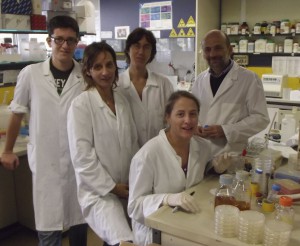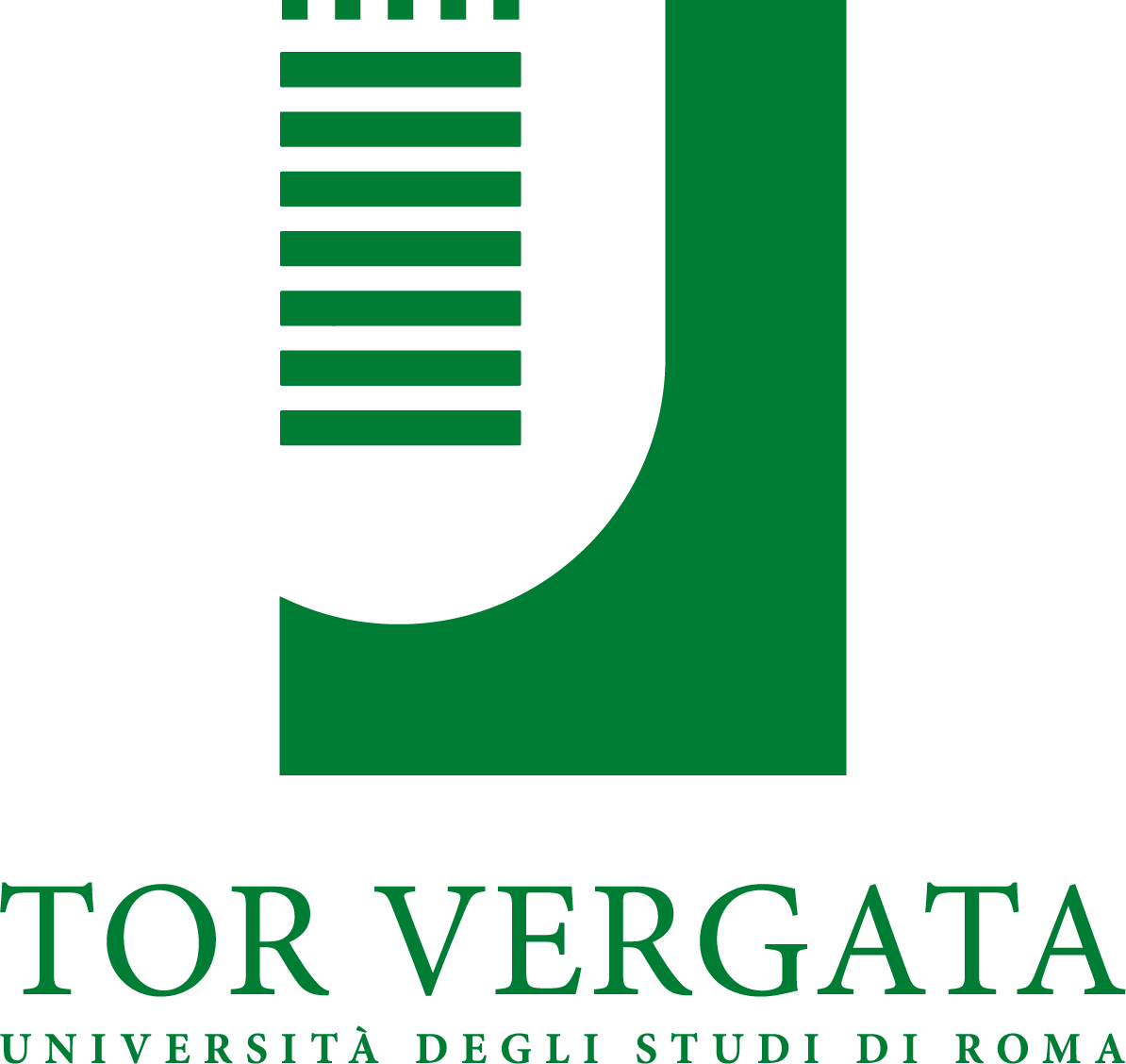 Curriculum Vitae
Curriculum Vitae
Biology degree (1986) 110/110 cum laude. University of Rome “La Sapienza”
PhD in Cellular and Molecular Biology (1991). University of Rome Tor Vergata
Since 1993 he is a stable member of the Department of Biology of the University of Rome Tor Vergata. Since February 2013 he is a full professor of Biochemistry. He currently teaches Industrial Biochemistry (LM Industrial Biotechnology); Cellular Proteomics Principles of Proteomics (LM Bioinformatics) and the short course of “Proteins of industrial interest”
He is co−author of nearly 100 papers published in international Journals indexed by Pub-Med (H index = 26, according to ISI WEB of Science). He acts as a reviewer for several Journals (including, J. Biol. Chem, Biochemistry, Infection and Immunity, Archives of Biochemistry and Biophysics, Microbiology) and national and international granting agencies. He is a member of the Editorial board of the Open Journal of Microbiology and of the World Journal of Biological Chemistry. He is a member of the following Scientific societies: American Society for Microbiology, The international Biometals Society, The Italian Biochemical Society and the Italian Society for the study of Cystic Fibrosis.
Financial support
Andrea Battistoni’s researches have received support from CNR, MURST, the Italian Ministry of Health, Fondazione Roma and the Italian Foundation for Cystic Fibrosis Research
Main Active collaborations
Dr. Paolo Pasquali – Istiituto Superiore di Sanità, Italy
Prof. Manuela Raffatellu, University of California Irvine, USA
Dr. Domenico Ciavardelli, University Kore of Enna, Italy
Research topics
Transition metals in the host-pathogen interaction
Metals play an essential role in all biological systems. In particular, transition metals such as zinc, iron, manganese and copper may be found in nearly 25% proteins which participate to important metabolic pathways and contribute to resistance to a variety of stress conditions. Therefore, it is not unexpected that bacteria have evolved complex machineries to ensure an adequate supply of these elements, while avoiding their potentially toxic intracellular accumulations. The recruitment of transition metals is particularly difficult for bacterial pathogens which must find the nutrients essential for their growth within the infected host, an environment where several essential elements are not freely available for infectious microorganisms. Since a long time it is known that the competition for iron binding between the host cell and the microorganism is one of the most important factors which determine the ability of pathogens to multiply and cause the disease. Only in recent years, a comparable role has been demonstrated for zinc.
In this context, our group investigates the uptake mechanisms of transition metals in different microorganisms (Salmonella enterica, Escherichia coli spp. and Pseudomonas aeruginosa), with particular interest for the structural properties, mechanisms of regulation and role in bacterial pathogenicity of ZnuABC , the main zinc transporter of Gram-negative bacteria.
On the one hand, our studies aim at a deeper understanding of the role of zinc in microbial physiology and of the interconnections between the homeostasis of this and other transition metals. On the other hand, we aim at developing new antimicrobial strategies based on the interference with the mechanisms of metal uptake or on the use of attenuated vaccine strains obtained by the deletion of the znuABC operon. In this regard, we have already demonstrated in several animal models that strains of S. enterica lacking znuABC stimulate a cell-mediated immune response, which confers a solid and durable immune-based protection against challenge infections with virulent strains
Role in pathogenesis and structural/functional properties of bacterial Cu, Zn Superoxide Dismutase
In order to kill invading bacteria, neutrophils and other specialized cells actively produce reactive oxygen species in a process primed by the single electron reduction of molecular oxygen to superoxide by the NADPH-oxidase complex. Several pathogens possess sodC genes, encoding the extracytoplasmic antioxidant enzyme Cu,Zn superoxide dismutase (Cu,ZnSOD). It has been proposed that Cu,ZnSOD might protect bacteria from oxygen free radicals generated by phagocytes and facilitate bacterial survival within the host. Studies carried out in our laboratory, bacteria belonging to the Salmonella genus, have established that these enzymes contribute significantly to the ability of the bacteria to proliferate in the host.The discovery that Cu,ZnSOD is able to modulate virulence has suggested that it could represent a target for novel antimicrobial strategies and has stimulated studies on its molecular properties. When compared to the eukaryotic enzymes of this class, bacterial Cu,ZnSODs show remarkable differences in the active site region, which is much more accessible to the solvent, and in the quaternary structure. Moreover, while all eukaryotic Cu,ZnSODs conform to a strictly conserved structural model, bacterial Cu,ZnSODs show greater divergence so that individual enzyme variants may exhibit unique properties. For example, we have identified and characterized Cu, ZnSODs from several pathogenic bacteria that: a) possess N-terminal domains that promote the acquisition of metals in environments where their concentration is low, b) exhibit a site for the binding of the prosthetic group heme; c) do not contain the zinc cofactor, but exhibit a normal catalytic activity. Our hypothesis is that the species-specific variations in the structure of these enzymes is part of the mechanisms of adaptation of each organism to the particular environmental conditions encountered in the course of infection.
Alterations in glutathione homeostasis in Cystic Fibrosis
As a consequence of CFTR mutations, the airway surface liquid (ASL) of Cystic Fibrosis (CF) patients is characterized by a marked decrease in reduced glutathione (GSH) and by the inability to modulate extracellular GSH concentration in response to oxidative stimuli or to bacterial infections. To evaluate the efficacy of therapies based on the administration of GSH, we are investigating the possible contribution of GSH to lung colonization by opportunistic bacterial pathogens.
We have recently shown that high levels of extracellular GSH can markedly reduce the ability of B .cenocepacia, a typical CF pathogen, to adhere and invade epithelial respiratory cells. (either stable cell lines or primary cells from the lung of a transplanted CF patient). This effect is correlated to a drastic reduction of the expression of the proinflammatory cytokines and to a GSH-dependent increase in the number of free thiols on the surface of epithelial cells. These results suggested that a major function of extracellular GSH is to is to maintain a correct oxidoreductive state in membrane proteins characterized by the presence of labile disulphide bridges,
We are currently investigating the effects of GSH on other CF pathogens and the mechanism of GSH-mediated inhibition of B. cenocepacia interaction with epithelial cells. These studies have already favoured the identification of other molecules able to inhibit bacterial invasion, which could be useful for the treatment of CF lung infections
Selected publications
1. Ciavardelli D, D’Orazio M, Pieroni L, Consalvo A, Rossi C, Sacchetta P, Di Ilio C, Battistoni A, Urbani A (2013) Proteomic and ionomic profiling reveals significant alterations of protein expression and calcium homeostasis in cystic fibrosis cells. Mol.Biosyst. 9, 1117-1126
2. Castelli S, Stella L, Petrarca P, Battistoni A, Desideri A, Falconi M. (2013) Zinc ion coordination as a modulating factor of the ZnuA histidine-rich loop flexibility: A molecular modeling and fluorescence spectroscopy study. Biochem Biophys Res Commun. 430, 769-73.
3. D’Orazio M, Pacello F and Battistoni A. (2012). Extracellular glutathione decreases the ability of Burkholderia cenocepacia to penetrate into epithelial cells and to induce an inflammatory response. Plos One, 7 e47550
4. Galli F, Battistoni A, Gambari R, Pompella A, Bragonzi A, Pilolli F, Iuliano L, Piroddi M, Dechecchi MC, Cabrini G. (2012). Oxidative stress and antioxidant therapy in cystic fibrosis. Biochem. Biophys Acta 1822, 690-713
5. Liu JZ, Jellbauer S, Poe A, Ton V, Pesciaroli M, Kehl-Fie T, Restrepo NA, Hosking M, Edwards RA, Battistoni A,Pasquali P, Lane TE, Chazin WJ, Vogl T, Roth J, Skaar EP and Raffatellu M. (2012) Zinc sequestration by the neutrophil protein calprotectin enhances Salmonella growth in the inflamed gut. Cell host and Microbe (2012) 11, 227-239.
6. Ciavardelli D, Ammendola S, Ronci M, Consalvo A, Marzano V, Lipoma M, Sacchetta P, Federici G, Di Ilio C, Battistoni A, Urbani A. Phenotypic profile linked to inhibition of the major Zn influx system in Salmonella enterica: proteomics and ionomics investigations. Mol Biosyst (2011) 7, 608-619
7. Ilari A, Alaleona F, Petrarca P, Battistoni A, Chiancone E. (2011) The X-ray Structure of the Zinc Transporter ZnuA from Salmonella enterica Discloses a Unique Triad of Zinc-Coordinating Histidines. J.Mol.Biol. 409, 630-641
8. Petrarca P, Ammendola S, Pasquali P, Battistoni A.. The Zur-regulated ZinT protein is an auxiliary component of the high affinity ZnuABC zinc transporter that facilitates metal recruitment during severe zinc shortage. J .Bacteriol (2010) 192: 1553-1564
9. Pasquali P., Ammendola, S., Pistoia, C., Petrucci, P., Tarantino, M.,Valente, C., Rotilio, G., Battistoni, A. Attenuated Salmonella enterica serovar Typhimurium lacking the ZnuABC transporter confers immune-based protection against challenge infections in mice. Vaccine (2008) 26, 3421-3426
10. Ammendola, S., Pasquali, P., Pacello, F., Rotilio, G., Castor, M. ,Libby, SJ, Figueroa-Bossi, N., Bossi, L., Fang F.C., and Battistoni, A. Regulatory and Structural Differences in the Cu,Zn-Superoxide Dismutases of Salmonella enterica and their Significance for Virulence. J. Biol Chem (2008) 283, 13688-13699
11. Ammendola S, Pasquali P, Pistoia C, Petrucci, P., Petrarca, P., Rotilio, G., and Battistoni, A. The high affinity Zn2+ uptake system ZnuABC is required for bacterial zinc homeostasis in intracellular environments and contributes to virulence of Salmonella enterica. Infect. Immun. (2007) 75, 5867-5876.
12. D’Angelo P., Pacello F, Mancini G., Proux O., Hazemann J.L., Desideri A. and Battistoni A. X-ray absorption investigation of a unique protein domain able to bind both Cu(I) and Cu(II) at adjacent sites of the N-terminus of Haemophilus ducreyi Cu,Zn superoxide dismutase. (2005) Biochemistry. 44, 13144-13150.
13. Battistoni A. Role of prokaryotic Cu,Zn superoxide dismutase in pathogenesis. Biochem. Soc. Trans. (2003). 6, 1326-1329.
14. D’Orazio M., Folcarelli, S., Rotilio, G. and Battistoni A. Lipid modification of the Cu,Zn superoxide dismutase from Mycobacterium tuberculosi.” Biochem. J. (2001) 359,17-22
15. Pacello, F., Kroll,S.J., Langford,P., Indiani,C., Smulevich, G., Desideri, A., Rotilio, G., and Battistoni, A. A novel heme protein: the Cu,Zn superoxide dismutase from Haemophilus ducreyi. J.Biol.Chem. (2001) 276, 30326-30334.
16. Battistoni, A., Pacello, F., Mazzetti,A.P, Capo, C., Kroll, S.J., Langford, P., Sansone, A., Donnarumma, G.,Valenti, P.,and Rotilio, G. A histidine-rich metal binding domain at the N terminus of Cu,Zn-superoxide dismutases from pathogenic bacteria: a novel strategy for metal chaperoning. J.Biol.Chem. (2001) 276, 30315-30325.
17. Battistoni, A., Pacello, F., Folcarelli, S., Ajello, M., Donnarumma, G., Greco, R., Ammendolia, M.G, Touati, D., Rotilio, G., and Valenti, P. Increased expression of periplasmic Cu,Zn superoxide dismutase enhances the survival of Escherichia coli invasive strains within nonphagocytic cells. Infection and Immunity. (2000) 68, 30-37.
18. Battistoni, A., Folcarelli, S.,Cervoni, L., Polizio, F., Desideri, A.,Giartosio, A., and Rotilio, G. Role of the dimeric structure in Cu,Zn superoxide dismutase. pH-dependent, reversible denaturation of the monomeric enzyme from Escherichia coli. J.Biol.Chem. (1998) 273, 5655-5661.
19. Battistoni, A., Folcarelli, S., Gabbianelli, R., Capo, C. and Giuseppe Rotilio. The Cu,Zn superoxide dismutase from Escherichia coli retains monomeric structure at high protein concentration. Evidences for altered subunit interaction in all the bacteriocupreins” Biochem. J. (1996) 320, 713-716.
20. Battistoni, A. and Rotilio, G. Isolation of an active and heat-stable monomeric form of Cu,Zn superoxide dismutase from the periplasmic space of Escherichia coli. FEBS letters (1995) 374, 199-202.
Andrea Battistoni, Professore Ordinario, Tel. 06-7259-4372 E-Mail andrea.battistoni@uniroma2.it
Francesca Pacello, (Funzionario tecnico) francesca.pacello@uniroma2.it
Serena Ammendola, (post doc) serena.ammendola@uniroma2.it
Melania D’Orazio, (post-doc) dorazio@bio.uniroma2.it
Mauro Cerasi, (Dottorando) mauro.cerasi@gmail.com






Università di Tor Vergata